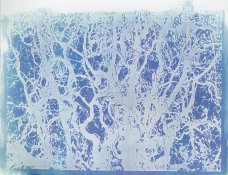Terry Christian
Member
Has anyone tried the new Lumi Inkodye light-sensitive dye yet? I received some today and attempted to print an image with my enlarger, but it seems that even with my lens wide open, too little light was getting through to excite the dye and I didn't want to run the risk of warping the film negative I was using. As of right now, the sun has set, so I'm trying to contact print something onto Inkodye-coated paper under my bathroom lighting (4 60-watt bulbs).  Lumi lists an 8-minute developing time for full sun and 16 minutes for a cloudy day, so this contact print should be done sometime in the next century!
Lumi lists an 8-minute developing time for full sun and 16 minutes for a cloudy day, so this contact print should be done sometime in the next century!  If my math is correct, that's a sensitivity of ISO 1/480.
If my math is correct, that's a sensitivity of ISO 1/480.
 Lumi lists an 8-minute developing time for full sun and 16 minutes for a cloudy day, so this contact print should be done sometime in the next century!
Lumi lists an 8-minute developing time for full sun and 16 minutes for a cloudy day, so this contact print should be done sometime in the next century!  If my math is correct, that's a sensitivity of ISO 1/480.
If my math is correct, that's a sensitivity of ISO 1/480.








 You appear to have bought it or used it without all of the needed information.
You appear to have bought it or used it without all of the needed information. 



